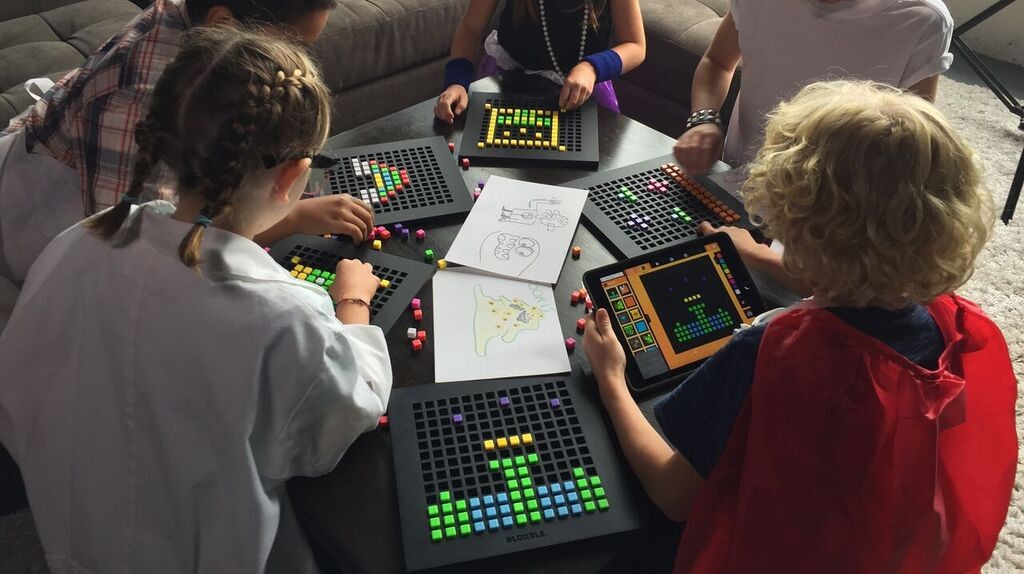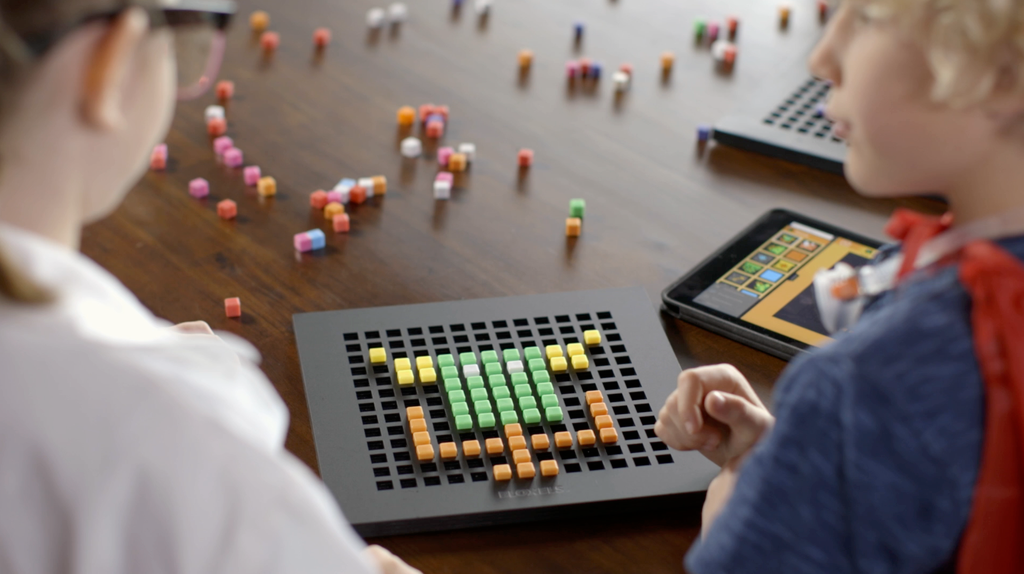
Bloxels mixes a Lite Brite-like toy with a digital maker app.
Bloxels, the newest brainchild of the company that developed Adventure Time Game Wizard and Floors, is often compared to the analog darling of old, Lite Brite. Its small pieces fit into a game board, creating colorful designs and a mosaic-like experience for kids.
But the similarities end there.
Pixel Press’ newest maker experience bridges the gap between the hands-on creative experience and the digital space, picking up where its product Floors left off. Place the colored blocks onto a non-electronic board, snap a pic, and upload your creation to the Bloxels Builder App. Each color corresponds to a different game element – such as coins, terrain, enemy characters and more – and once your game has been created, it can be played and shared online.
With plenty of digital-only creator games on the market, why use a physical toy to build at the digital level?
“A lot of the toys-to-life [market] is really treating the toy as a key to unlock content in the digital space, but we’re really using the toy as a creative medium to creating content within the video game space,” Pixel Press CEO Robin Rath said.
According to Rath, that creative element is the key to making the building experience more accessible to kids of all abilities. Designed with 8– to 12-year-olds in mind, Bloxels has been used by kids as young as 5.
Rath said that although they are leading with the toy aspect of the product, Bloxels was also designed to be applied to a wide array of educational goals, from digital content creation to discipline-specific skills demonstration. For example, Rath cited one activity called “Presidential Run” that invites students to research a U.S. president and then create a video game around their knowledge of that president.
The educational uses are no accident as Rath said there has been an increase in sales and interest coming from teachers.
In addition to specific content-area learning (from art to math and coding), Bloxels helps kids learn to work together, Rath said, which he said is the core of the game’s educational value.
“We don’t really go over and above in terms of stressing what the Common Core values are specifically, but we do very much focus on the fact that from the collaborative perspective it’s easy for kids to learn to work together — and then from the creative perspective this is a great way for them to demonstrate a lot of their creativity,” Rath said.
Bloxels can be used to teach the content creation process – from the story to the artwork to some dabbling in computer science – but perhaps more importantly, Rath emphasized the value of using the toy to teach “design thinking” skills in that collaborative environment.

And even though the materials aren’t explicitly aligned with the Common Core, Bloxels provides one- and five-day lesson plans that do align with specific Next Generation Science Standards. Both sets of lessons focus on those design thinking skills, defined in the lessons as “a user-centered (or better put, student- centered) approach for solving everyday problems made popular by the Stanford Design School.”
“It is all so integrated,” Rath said. “… We look at art as a critical component, as far as education goes. There’s education baked into so many things that we do.”
Much of Bloxels’ reach into the education market has been thanks to the relative popularity of Pixel Press’ previous building and making games in the classroom environment. But to build an even stronger presence in the edtech world, Pixel Press is working on developing referral programs which will allow teachers to earn extra physical or digital content.
Overall, Pixel Press raised $68,000 in Kickstarter funding specifically for Bloxels, after a successful $110,000 campaign for Floors. Although the initial campaign emphasized a pre-built game experience that could be customized, Rath said the company’s backers encouraged more artistic flexibility – so the product shipping this week allows for that extra level of creative license.
Pixel Press worked with co.lab, a San Francisco-based accelerator, between July and September to help meet the challenges of the physical-to-digital space. Those challenges include perennial questions of hardware and COPPA compliance, especially when marketing to teachers and parents.
Bloxels ships to Kickstarter contributors and pre-order customers this week. Though the company originally anticipated an October release, manufacturing delays contributed to a post-holiday season ship date. Rath said this delay was disappointing to backers hoping to have the kit in time for Christmas, but “most of our supporters understood the delays,” he said in an email, “and we did our best to keep them in the loop along the way.”
Next up, Pixel Press will be at Toy Fair New York in February in what Rath called the conference’s “tech alley,” alongside companies such as Tiggly, GoldieBlox and other companies working to bridge the gap between the physical and the digital. Last year, Bloxels was recognized as one of 11 products as Best of Toy Fair New York 2015, and Rath is glad to see tech gaining momentum in the toy world.
“It’s cool to see, within this old-school industry, this growing technology space,” Rath said. “Now there’s a legitimate space where this is happening and it’s really exciting.”
